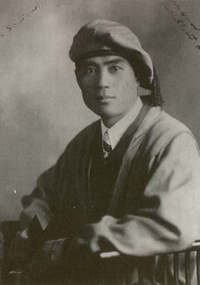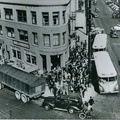Read Part 20 >>
THE CREATIVE SPIRIT
Despite the rigors of daily life, the Issei found time for creative expression. In cities and towns, groups formed to study and perform traditional dances, songs, and to play musical instruments such as the shamisen (three-stringed instrument), koto (harp), shakuhachi (flute), and biwa( lute). In Hawaii classical Okinawan entertainment was preserved and popularized by musicians such Kosuke Nakaganeko (1908-1990), master teacher and performer of the sanshin, an Okinawan three-stringed guitar.
Amateur drama groups formed in both Hawaii and on the Mainland, performing kyogen (comedic plays), shimpa (modern plays), and kabuki in theaters and halls.
A popular event for any community was the silent films from Japan, which made the rounds to various plantation towns in Hawaii and communities large and small on the Mainland. The silent films called for the talents of a benshi, or skilled narrator, who performed all the roles to the occasional accompaniment of the shamisen player.
The most famous Issei of the American silent screen was Sessue Hayakawa (1890-1973) an internationally renowned matinee idol of the 1910s and 1920s. Hayakawa starred in more than 120 films and in 1920 commanded $7,500 a week. In his 32-room castle he played host to friends such as Francis X. Bushman, Rudolph Valentino, and Mary Pickford.
In every Japanese community, poetry clubs flourished with local poets gaining recognition and esteem when their poems appeared in local newspapers. Among them was Teiko Tomita (1896-1990) who came to America in 1921 to farm on the Yakima Indian Reservation in Washington. Tomita composed tanka, a poetic form consisting of thirty-one syllables arranged in lines of five, seven, five, seven, and seven syllables successively. Her poetry captured new metaphors, images, language, and experiences within the traditional form.1
Carefully grafting
Young cherry trees
I believe in the certainty
They will bud
In the coming spring2
One of the few artists in the community who could make a full-time living at his or her craft was the local photographer who was always present at weddings and funerals. One of the most noted Issei photographer was Toyo Miyatake (1895-1979), a leading figure in Los Angeles’ Little Tokyo where he was known as the community’s official photographer.
Miyatake came to the United States in 1909 to join his father who had started a confectionary store in Los Angeles. While working full-time in his father’s store, Toyo decided “Candy business isn’t for me…I wanted to be an artist, if I could, but it was difficult to be an artist and make it go. So I decided to be a photographer.”3
In 1918, Miyatake started studying photography with famed photographer Harry Shigeta, who taught classes in a small hotel on the corner of Second Street and San Pedro in Little Tokyo. After several years of taking pictures of friends and eking out a living, Toyo opened the Miyatake Studios in 1923. Many decades later, he would become renowned for photographing daily life in Manzanar, one of ten concentration camps used to incarcerate over 100,000 people of Japanese ancestry during World War II.

Graduation photo of Henry Sugimoto from California College of Arts and Crafts, Oakland, California, 1928 (Gift of Madeleine Sugimoto and Naomi Tagawa, Japanese American National Museum [92.97.147])
Another Issei who is perhaps best known for his poignant depictions of concentration camp life in Jerome and Rohwer, was fine artist Henry Sugimoto (1900-1990). Upon leaving the Fresno Assembly Center where he and his family interned in 1942, Sugimoto brought “a few tubes of pigment, three brushed. And a small bottle of turpentine. But I don’t have any canvas, no paper. So I use my sheets and pillow case and mattress. That mattress bag I took with me fortunately from the assembly center, so I started to stretch it and I started to paint.”4
Born in Wakayama, Japan, Sugimoto came to the United States at the age of eighteen to join his parents in Hanford, California. After graduating high school, he enrolled in the University of California at Berkeley but soon transferred to the California College of Art where he received his B.F.A. in 1928. The following year he left for Paris where he studied at the Academic Coroarossi and exhibited his works at the Salon d’Automne. Sugimoto, a prolific and versatile artist, continued to paint until his death in May 8, 1990.
A Rennaisance man who bridged many art forms was Sadakichi Hartmann (1867-1944), known as the “King of Bohemia.” Beginning in the 1890s, Hartmann made a name for himself as an author, lecturer, poet, dancer, and internationally famous art critic. Born on the island of Deshima in Nagasaki, Hartmann was the son of an affluent German trader and a Japanese mother, who died in childbirth. Raised in Germany by a wealthy uncle, and his grandmother, Hartmann attended private schools and by the age of nine had read all the works of Goethe and Schiller. After angering his father by dropping out of a naval academy and running away to Paris, Hartmann found himself sailing off to America to live with an uncle. He was approximately fourteen years old.
His multiple talents and the originality that made him a “pathfinder,” brought him into the circles of some of the most famous intellectuals and artists of his day. A self-proclaimed genius, he would begin an anecdote by saying’ “On a day like this, there were Rodin, Whitman, myself and three beers in a café in Vienna. . .”5
While teased for being a “no-good drunken bum” by W.C. Fields and a “truculent poseur” by Ben Hecht, he as praised by Walt Whitman and thought highly enough by some that “The Sadakichi Hartmann Newsletter” was regularly published some twenty-five years after his death. The recognition of the contributions to American art and photography have emerged since the 1960s.6
Notes:
1. Gail Nomura, “Tsugiki, a Grafting: A History of a Japanese Pioneer Woman in Washington State,” in Karen J.Blair (Ed.), Women in PacificNorthwestHistory, (Washington, 1988), pp. 207-230.
2. Ibid, p.214, poem by Teiko Tomita.
3. Toyo Miyatake interview, “A Life in Photography: The Recollections of Toyo Miyatake,” Oral History Program, Claremont Graduate School, Claremont, California, 1978, p. 10.
4. Deborah Gesensway and Minday Roseman, Beyond Words, Images from America’s Concentration Camps (Ithaca, 1989), pp. 36-37.
5. Linton, Wisteria Hartman, The Life and Times of Sadakichi Hartman, 1867-1944, a catalogue for an Exhibition presented and co-sponsored by the University Liberty and the Riverside Press-Enterprise Co. at the University of California, Riverside (Riverside, 1970), p. 6.
6. See Harry W. Lawton and George Knox (Eds.), The Valiant Knights of Daguerre (Berkeley, 1978).
*Issei Pioneers: Hawai‘i and the Mainland, 1885-1924 is the catalogue accompanying the National Museum’s inaugural exhibition. Using artifacts from the National Museum’s collection to tell the story of the courageous “Issei Pioneers,” the catalogue focuses on the early immigration and settlement years. To order the catalogue >>
© 1992 Japanese American National Museum





